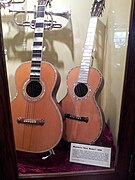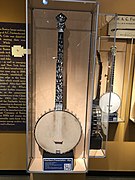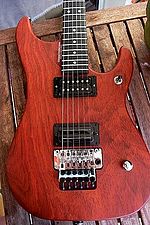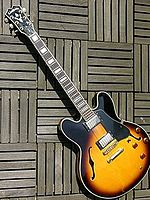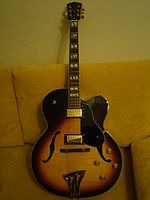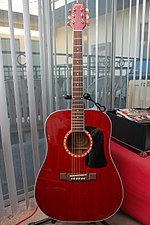Washburn Guitars
 | |
| Company type | Subsidiary |
|---|---|
| Industry | Musical instruments |
| Founded | 1883inChicago, Illinois |
| Founder | George Washburn Lyon |
| Headquarters | , United States |
Area served | Worldwide |
| Products | Electric,acoustic&resonatorguitars Bass guitars Banjos Mandolins Ukuleles Amplifiers |
| Parent | U.S. Music Corp. |
| Website | washburn |
Washburn Guitarsis an Americanbrandand importer ofguitars,mandolins,and otherstring instruments,originally established in 1883 inChicago, Illinois.The Washburn name is controlled byU.S. Music Corp.,asubsidiaryofCanadiancorporate groupExertis|JAM.[1]
Corporate history
[edit]1864-1940
[edit]
Lyon & Healybegan in 1864 as a partnership of businessmen George W. Lyon and Patrick J. Healy, acting as theChicagooutlet forBostonsheet musicpublisherOliver Ditson and Company.By 1865, Lyon & Healy had expanded intoreed organsand some small instruments. The company achieved independence by 1880, and around 1888 the company launched fully into fretted and plucked instruments (guitars,mandolins,banjos,ukulelesandzithers)[2] under the "George Washburn" brand, which was Lyon's first and middle name.[3]Lyon & Healy 1898 catalog listed 28 different styles of "Washburn" guitars, ranging from $15 to $145.[3]
Tracing the history of any particular instrument of this period presents many obstacles. Not only did the Lyon & Healy company often change designs to follow the rapidly evolving consumer demand, but the company also repaired instruments, and offered engraving services, including decorating instruments that it retailed but did not actually manufacture. As well, they built instruments for other retailers and distributors under varioushouse brands,andoutsourced constructionof some models.
In 1912, Washburn introduced the Lakeside Jumbo guitar, which some consider the first dreadnought-sized guitar.[4]It bridged the gap between smaller-bodied "parlor" guitars of the late 19th and early 20th century and modern-daydreadnought and jumboacoustic guitars.
George Lyon retired from the company in 1889 (died 1894). Patrick Healy then led the company into a period of major expansion, beginning with a larger new factory and improved mass-production techniques, and soon dominated the domestic market.[5]Their 1892 catalog claimed to manufacture 100,000 instruments annually. Healy died 1905.

By the 1920s, Lyon & Healy faced growing competition from other instrument manufacturers as well as from the rise of other forms of entertainment, particularlyfilmandthe gramophone.Lyon & Healy gradually shifted manufacturing chores onto wholesaler Tonk Brothers, to whom they sold the guitar portion of the business in 1928, continuing to produce their own lines of harps, pianos, and organs.
Tonk Brothers turned to manufacturer J.R. Stewart Company to purchase and operate the massive factory, but this transition proved problematic and Stewart went bankrupt in 1930. Some of the Stewart assets were acquired by theRegal Musical Instrument Company,which had purchased the "Regal" brand name in 1908 from Lyon & Healy (who acquired it in 1905). Regal was chosen to reopen the Washburn factory (producing Regal instruments as well). Though the Washburn brand was preserved, it never regained its preeminence, and by the early 1940s had declined to nothing.
Revival
[edit]An unbroken lineage is often alluded to by Washburn International, in press releases and advertising materials, and on the company website:
Washburn has been building stringed instruments since 1883.… 130 years of history is at the root of our strong foundation building high quality instruments.[6]
However, there is no direct connection between the original Washburn brand and the modern Washburn International.
In the early 1960s, retail storeThe Chicago Guitar GalleryhiredRudolf "Rudy" Schlacher,a young Germanviolin builder,as a repair technician. A few years later, Schlacher openedThe Sound Post[7][8]in Evanston, Illinois, to focus on guitars. He soon realized the sales potential for quality instruments of modest cost.
Tom Beckmen and his wife Judy Fink Beckmen in 1972 left careers as music salesman and teacher (respectively) to launch a wholesale music business in Los Angeles, Beckmen Musical Instruments. It was Beckmen Music that resurrected the Washburn name, and beginning in 1974 applied it to a series of quality imported acoustic guitars, made in Japan by Terada, as well as a selection of mandolins and banjos.
Fritz Tasch, Rudy Schlacher and Rick Johnstone, asFretted Industries, Inc.,acquired the Washburn name in 1977 (for $13,000) when the Beckmens took their business a different direction,[9]and so the Washburn name was returned to Chicago. With assistance fromIkutaro Kakehashi(founder ofRoland Corporation), Schlacher was able to find instrument factories in Japan that could meet the desired standards.[10]
Fretted Industries acquired other lines as well, such asOscar Schmidtautoharps.
Schlacher bought out Johnstone in 1987, and changed the company name toWashburn International.A stateside manufacturing operation was opened in 1991 for higher-end, short-run, and one-off instruments, as well as development and prototyping. That year, aChicago Tribunearticle[11]confidently places Washburn "among the top three guitar manufacturers in the world," behind onlyFenderandGibson.
On December 15, 2002, Washburn International announced that it had completed acquisition ofU.S. Music Corporation,[12]and would be rolling its assets into that company in areverse merger.[13]Schlacher remained asCFO,appointingGary GryczantoCOO;Gryczan had been Washburn's CFO from 1995 through 1998. The new USM's headquarters were inMundelein(440 E. Courtland Street), which also housed the stateside Washburnluthiery,"the USA Custom Shop," previously located at Elston and Springfield avenues.
Schlacher announced completion of selling USM toJAM Industrieson August 24, 2009, and that he would be stepping away from his company after fully four decades.[14]
We are pleased to join forces with a strategic partner like Jam Industries, that has a long, successful history in the music industry and has been a long-term business partner with U.S. Music for more than 20 years. It has been a thrilling and rewarding 40-year ride that has allowed me to realize my dreams and goals.[15]
AsR S Consultinghe remained a consultant to the musical-instrument industry[16]and was an executive producer for a small-budget film[17]
The corporate offices of U.S. Music were relocated toBuffalo Grove, Illinoisin 2012.
Production
[edit]Very few modern Washburn instruments have been built by the company itself. It has relied on outside factories and luthiers to fulfill their designs and meet public demand.
The first modern Washburn instruments were full-size acoustic guitars imported from Japan by Beckmen Music. The 1974 range included one folk-style guitar (W-200) and eight dreadnoughts of increasing quality and decoration: W-240-12, W-250, W-260, W-280, W-300, W-300-12, W-500, W-600.
Under Rudy Schlacher, most Washburn models were ordered in runs of 200 units, rather than ongoing production; if sales went well, further runs might be ordered. This application ofjust-in-time manufacturing(orlean manufacturing) kept the company from needing to warehouse and liquidate overproduction, improving profitability. As a result, Washburn models (acoustic or electric) sometimes became difficult to locate between production runs.
The first Washburn electric guitars were the Wing Series models, offered 1978–1984. These instruments featured innovative push-pull split humbuckers, brass hardware and inlays, andneck-throughconstruction. Some early Wing Series were produced by Yamaki, one Japanese manufacturer of Washburn acoustic guitars.
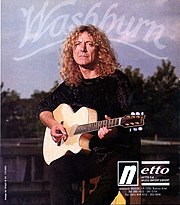
By 1991, production of Washburn instruments had shifted almost entirely to Korea, built bySamick.When Samick opened theirCileungsi,Indonesia, facility in 1992, this factory also began to produce Washburn-branded instruments, generally identifiable by an "SI-" serial number prefix.
From 1992 to 2000 Washburn housed the USA Custom Shop in a factory at Elston and Springfield avenues. Grover Jackson ran production for the first half of the 1990s and Larry English ran production for the second half of the 1990s.
Between 1994 and 2001, ten models of acoustic guitar were built for Washburn in the United States, five byTacoma Guitars(Tacoma, Washington) and five byBourgeois Guitars(Lewiston, Maine).
Washburn brought out a line of four USA-made dreadnoughts, available from 2002 to 2008. These were the D-78, D-80, D-82, and D-84. (All had the "-SW" suffix, for "solid wood," indicating that no laminate wood was employed.)
In 2012, when JAM Industries declined to renew the lease on the Mundelein facility, the Washburn luthiery closed. At the time, the Washburn facility was the ninth-largest employer in the village (the third-largest business), providing 180 jobs.[18]The stated intent was to reopen at a smaller building in Buffalo Grove (1000 Corporate Grove Drive)[19]but this did not materialize. A few Washburn models (particularly the N4) are produced in Cincinnati.
As of 2017, primary production has largely shifted from Korea to factories in Indonesia and China.
Innovations
[edit]Most widely known for its guitars (bothelectricandacoustic), Washburn also makeselectric basses,acoustic basses,banjos,mandolins,travel guitars,ukuleles,andamplifiers,as well as accessories including guitar cases, clothing,tuners,and straps.[20]
In the 1980s, Washburn introduced theFestival Seriesof acoustic/electric guitars (the EA series, for "electrified acoustic" ). They were thinner than standard acoustic guitars and less acoustically resonant by design, thereby reducing susceptibility tofeedback,a significant problem using acoustic or electrified acoustic guitars in large-venue performances. The addition in later models of sound slots (rather than the traditional round soundhole), a patented innovation, further reduced the possibility of feedback, and the guitars quickly became the go-to stage acoustic for artists such asJimmy Page,George Harrison,andBob Dylan.In the early 1990s whenMTVintroduced theirUnpluggedseries, hardly a show went by without seeing a Festival Series guitar. The design also lent itself well to acoustic basses, and Washburn's AB Series quickly became popular both for its look and its tone, whether amplified or unplugged.

In recent years, Washburn licensed several guitar construction features:
- theBuzz FeitenTuning System— a corrected temperation tuning formula, using a compensated nut and saddle to minimize the inherentintonationproblems of the Western tuning formula. The BFTS was first used by Washburn in 1995 on a very few models, then increasingly with the introduction of the WI-64 (1999), and was entirely phased out after the 2010 production year. At its peak, this system came standard on U.S.-made Washburn guitars and basses and the better imports.[21]
- Stephen's Extended Cutaway— a uniquebolt-onneck joint invented by luthier Stephen Davies to allow greater unrestricted access for a guitarist's fretting hand. Used primarily with the Nuno Bettencourt signature models, the SEC has also been employed with acoustic guitars, and remains on some current (2017) models of the Parallaxe line.[22]
- Voice Contour Control (VCC)— a special potentiometer and wiring, intended to allow access to the entire range of tones "between" the one-coil ( "single-coil" mode) and two-coil sounds of ahumbuckingpickup,rather than one or the other.[23]
- VCC is similar to coil splitting, in that it changes the tone of a humbucking pick-up to that of a single coil, but it does it by turning the tone knob… without the hum normally associated with single coils.
- Designed by Trevor Wilkinson, the VCC is no longer in use by Washburn, but is available in various models of Vintage (UK) guitar as the "Roll Control" knob.
Model number suffixes
[edit]Over the past 40 years, Washburn has accreted a system of identifying some of the most pertinent features in many of its acoustic instruments and some of the electric. Additional letters may be used to indicate the instrument's finish. While imperfectly applied, and sometimes awkwardly long, this can often be useful in identifying a given guitar.
- suffix —
- C - cutaway
- DL - deluxe (generally, a standard model with a few upgraded features)
- E - electric (i.e., built-in pickup)
- K - kit (i.e., includes case or gig bag)
- LH - left-handed
- M - mahogany top
- Q - quilt maple top
- R - rosewood
- S - solid-wood top (rather than laminate)
- SP - spalt maple top
- SW - solid wood used throughout
- V - vibrato (on electric guitars)
This often combines with the prefix to tell a guitar's story. For example, the WLG110SWCEK indicates that it's part of the Woodline series (WL-), likely top of the line (110), Grand Auditorium (G) size, all solid wood, cutaway, piezo pickup, and originally included a case.
Past and present models
[edit]Any given series may have as few as only one model.
Electric guitars
[edit]| prefix | Series | a.k.a. | type | duration | comments |
|---|---|---|---|---|---|
| J | Jazz | hollowbody archtop | 1989-date | ||
| HB | Hollow Body | semihollow archtop | 1981-date | ||
| B | Bantam | headless bass | 1984-1986 | no connection to 1990s Bantams | |
| GB | Bantam | headless bass/guitar | 1984-1986 | no connection to 1990s Bantams | |
| G | Bantam | headless guitar | 1984-1986 | no connection to 1990s Bantams | |
| CT | Centurian | carved-top | 1997-2002 | ||
| P | Centurian | carved-top | 1997-2002 | ||
| E | Centurian | carved-top | 2001-2002 | ||
| CP | Culprit | 1998-2000 | |||
| Dime | Dimebag Darrell | ML-style | 1995-2004 | signature line | |
| G | Force | 1983-1988 | |||
| CS | Hard Rock | 2000-2002 | |||
| NX | Nextar | 2002-2003 | Stephen's Extended Cutaway | ||
| PT | Poptop | 2000-2002 | |||
| RS | Hard Rock | Rogue Star | 2000-2002 | ||
| WG | Hard Rock | 2000-2002 | |||
| WR | Hard Rock | 2000-2002 | |||
| HM | 2008-2010 | Series, not prefix | |||
| WI | Idol | 1999-2010 | |||
| WM | HM | 2008-2010 | no connection to 1990s WM | ||
| WV | Wavepoint; Vee | 2008-2010 | |||
| WIN | Idol | 2010-2014 | |||
| JB | Jennifer Batten | 2000-2004 | signature line | ||
| KC | Chicago | 1989-1991 | |||
| LS | Laredo | Legacy; Silverado | S copy | 1992-1994 | |
| LT | Laredo | Legacy; Silverado | T copy | 1993-1994 | |
| MR | Magnum | 1997-2000 | |||
| BT | Maverick | BillyT; Bantam | 1995-2002 | all 24.75 "scale | |
| WM | Maverick | 1997-2002 | USA build; no connection to 2008 WM | ||
| DD | Maya | Dan Donegan | 2005-2010 | signature line | |
| MG | Mercury | 1992-1996 | |||
| NC | Nick Catanese | 2005-2009 | signature line | ||
| N | Nuno Bettencourt | 1990-date | Stephen's Extended Cutaway | ||
| PS | Paul Stanley | 1998-2016 | signature line | ||
| RX | RX | 2011-date | |||
| SI | Scott Ian | 2005-2010 | signature line | ||
| A | Stage | 1980-1986 | |||
| EC | Extended Cutaway | 1988-1991 | Stephen's Extended Cutaway | ||
| SS | Steve Stevens | 1993-1994 | |||
| AF | Tour | Ace Frehley | 1987-1988 | signature line | |
| FV | Tour | Flying Vee | 1984-1985 | ||
| HM | Tour | 1985-1987 | |||
| RR | Tour | 1985-1987 | |||
| RS | Tour | 1987-1988 | |||
| WP | Tour | Paul copy | 1987-1991 | ||
| WT | Tour | 1984-1994 | |||
| Wing | 1978-1985 | ||||
| SB | Wing Reissue | 1991-1995 | |||
| X | X | 2002-2010 | |||
| XM | XM | 2011-date | |||
| S | Sonamaster | 2016-date | |||
| PX | Parallaxe | 2013-date | |||
| PXM | Parallaxe | 2013-date | |||
| PXS | Parallaxe | 2013-date | |||
| PXL | Parallaxe | LP shape | 2013-date | ||
| TB | Tabu | 2009 | |||
| WB | Lyon | S copy | 1994-1995 |
Basses
[edit]| prefix | Series | a.k.a. | type | duration | comments |
|---|---|---|---|---|---|
| B | 1983-1985 | ||||
| B | 1992 | ||||
| Wing | Scavenger | 1980-1981 | |||
| B | Stage | 1981-1984 | |||
| B | Stage | 1981-1984 | |||
| B | Force | P copy | 1983-1986 | ||
| B | ABT | 1987-1989 | |||
| XS | Axxess | 1990-1991 | |||
| BB | Bantam | 2006-2010 | |||
| XB | Bantam | 1994-2006 | |||
| MB | Mercury | 1992-1993 | |||
| MB | Mercury | 2002-2006 | |||
| RB | RB | 1999-2003 | |||
| WP | Shadow | P copy | 1997-1999 | ||
| WJ | Shadow | J copy | 1997-1999 | ||
| S | Status 1000 | 1988-1993 | |||
| SHB | Stu Hamm | 2012-2016 | signature | ||
| T | Taurus | 2002-date | |||
| AB | 2004-2006 | ||||
| Bootsy Collins | Space Bass | 2002-2006 | |||
| CB | 2007-2010 | ||||
| DB | 2000 | ||||
| Force | 2002-2010 | ||||
| M | 2002-2003 | ||||
| WB | Idol | 2007-2010 | |||
| SB | Sonamaster | 2016-date | |||
| AB | Festival | Acoustic | 1988-date |
Acoustic guitars
[edit]| prefix | Series | shape | duration | type | comments |
|---|---|---|---|---|---|
| RW | Roger Waters | 2004 | acoustic/electric | RW300 signature (USA) | |
| D | dreadnought | 1978-2010 | |||
| WD | dreadnought | 2011-date | |||
| R | 125th Anniversary | parlor | 2008-2009 | ||
| WSJ | 125th Anniversary | southern jumbo | 2008-2009 | ||
| D | southern jumbo | 1985-2000 | |||
| F | folk | 1978-2010 | |||
| WF | folk | 2012-date | |||
| WG | grand auditorium | 2011-date | |||
| J | jumbo | 1991-2010 | |||
| SJ | southern jumbo | 2004-2005 | |||
| WB | baby jumbo | 2007-2010 | |||
| WJ | jumbo | 2011-date | |||
| PS | Paul Stanley | dreadnought | 2007 | ||
| PS | Paul Stanley | folk | 2007 | ||
| PR | Prairie State | 1920s | 2002-2003 | ||
| DC | dreadnought | 1987-1994 | Stephen's Extended Cutaway |
Endorsers
[edit]Washburn uses the mechanism of endorsements, where:
- Manufacturer provides custom-shop instrument that suits the artist best, for free (or even paying artist).
- Artists promotes his or her usage of that instrument andadvertisesmanufacturer company.
The currentlist of Washburn Signature endorsers.
StandardWashburn Endorsers.
Product lineup
[edit]2017 Signature Lines
[edit]
- Nuno Bettencourtmodels are flagshipped by the American hand-madeN4.The N4 is a small reverse-headstock"super-strat"that features theStephen's Extended Cutawayneck joint for easy access to the higher frets. It is outfitted with aBill Lawrenceand aSeymour Duncanpickup, and a licensedFloyd Rose-type tremolo. TheN1andN2are production (budget) models of this line, factory-built inKorea,and feature standard bolt-on necks and lower-grade pickups and tremolo systems. The N3 (discontinued) was also produced in Korea and sported the Stephen's Extended Cutaway but used lower-grade pickups.
Bettencourt has endorsed several Washburn acoustic models as well. There is the N7 7-string model, and an acoustic/electric based on the Festival Series, the EA20SNB. - Ola Englund Solar(2013/2014): Signature model announced by Washburn in 2013 for Swedish guitaristOla EnglundofSix Feet Under,Feared, andThe Haunted.[24]
- Warren Haynes- vocalist and guitarist,Gov't Mule,The Allman Brothers,and the Warren Haynes Band. The Washburn WSD5249 acoustic guitar is based on the original Washburn Solo Deluxe from 1937, which is similar in size to the popular OM shaped guitars on the market today. Adirondack Spruce top with period-correct vintage sunburst finish. Hand-shaped scalloped Adirondack Spruce bracing, solid rosewood sides, 2-piece back with vintage-inspired 1930s zipper-style inlaid herringbone stripe. The top has 3-ply ivoroid binding and the sound hole is finished by a ringed herringbone rosette.[25]
Previous signature instruments
[edit]
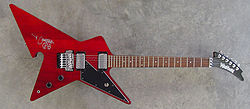
- "Dimebag Darrell" AbbottWashburn'sDean-ML-styleDime 333and radicalExplorer-likeDime Culpritmodels were the most popular. The Dime 333 had aFloyd Rosedouble-locking tremolo; the332variant featured a stop-tail bridge. The Culprit, with its sliced-up Explorer-style body, featured aFloyd Rosetremolo, a mirror pickguard and a pair of hot ceramic humbucking pickups with chrome cover.

- Paul StanleyModels for 2014 were the PS2014, PS2012, PS 12 and PS10.[26]Previous models have been the PS600 and PS800 (extensively used while touring withKISS), as well as the "Preacher" PS7000/PS7200/PS9000/PS9200 (used during the 2006-2007 tour to promote his solo albumLive to Win). Stanley's line also includes the PS9 and PS11E acoustic guitars that feature his image on the front and come bundled with a customgig bag.
- Jennifer Batten— three guitars based on the WM (the USA version of the Maverick BT Series guitars). All had three single-coil pickups:JB-80(Korea),JB-100(USA),JB-100 MIDI(USA) with installedRolandGK-2A divided pickup system.
- Steve Stevens Signature Model(1993) — SS80 and SS100 models made at Washburn's Chicago custom shop, the SS40 mass-produced in Korea. The SS80 was produced in black with gold hardware, aSchaller-licensedFloyd Rosetremolo, andSeymour DuncanJB humbucking pickups. The SS100 featured black hardware andFrankenstein monstergraphics.
- George Washburn/ Stephens Extended Cutaway electric models — introduced in 1987, designed entirely by Stephen Davies. The series comprised the EC-26Atlantis,the EC-29Challenger,and the EC-36Spitfire.The EC-29 and EC-36 were the first mass-produced guitars that had over 27 frets. The 26-fret EC-26 was made in the United States and is a very rare model.
- Nick Catanese Signature Model(1999) — Idol Series (WI) models forNick Catanese.
- Stu Hamm- signature electric basses designed withStu Hamm.[27]
- Dan Donegan Signature Model/Maya Series(2003) — six-string electric guitar series forDisturbedguitaristDan Doneganand named after his daughter Maya: the Maya Standard (DD-70) and the Maya Pro (DD-75). Both useSeymour Duncanpickups.
- Bootsy Collins Space Bass(2006): model forBootsy Collins.FeaturesFender Jazz Basspickups.
References
[edit]- ^"JAM Industries Rebrands as Exertis JAM and Reaffirms Commitment to Core Values".Yahoo.Yahoo. 13 October 2021.Retrieved5 April2022.
- ^ Hubert Pleijsier (2008).Washburn Prewar Instrument Styles.Anaheim Hills, CA: Hal Leonard. p. 3.ISBN978-1-57424-227-0.
- ^abOdell, Jay Scott (2001). "Washburn, George".Grove Music Online(8th ed.).Oxford University Press.doi:10.1093/gmo/9781561592630.article.29934.ISBN978-1-56159-263-0.
- ^ John Teagle, U.S. Music Corp. (1996).Washburn, Over One Hundred Years of Fine Stringed Instruments(1st ed.). New York: Amsco Publications. p. 73.ISBN0-8256-1435-X.
- ^Bacon, Tony (1 September 2001).The history of the American guitar: 1833 to the present day(1st ed.). Hal Leonard.ISBN9781617130335.
- ^http:// washburn /community/"The History of Washburn Guitars"
- ^[1],heading of "Rudy Schlacher" video inNAMM Oral History Program.
- ^"Grand Piano Haus: The history of Grand Piano Haus"
- ^[2]:Beckmen Music becameRoland's distributor for the western United States in 1976, and in 1978 a 50% partner in foundingRoland USA.The Beckmens sold their share back to Roland in 1993 and bought a vineyard in the Santa Ynez Valley.
- ^Di Perna, Alan (July 2009)."Burning for you"(PDF).Guitar World.Retrieved7 March2017.
- ^"Guitar-maker Strikes Comeback Chord: Washburn Hits The Top 3 On 15 Years Of Growth",February 17, 1991
- ^[3]Hoovers, entry: U.S. MUSIC CORPORATION Company Profile
- ^U.S. Music press release,12/15/2002
- ^"Schlacher Says Farewell"
- ^U.S. Music press release, 08/24/2009,in Music Inc Magazine
- ^LinkedIn entry "Rudy Schlacher"
- ^IMDB entry:Steel Panther: The British Invasion
- ^Village of Mundelein 2011 Comprehensive Annual Financial Report
- ^[4],Guitar maker leaves Mundelein.
- ^ "Washburn History".Washburn Guitars / U.S. Music Corp., a division of JAM Industries, LTD.
- ^ "Buzz Feiten Tuning System".Washburn Guitars. Archived fromthe originalon 2011-12-21.
- ^ "The Washburn Days".Stephen's Extended Cutaway.2010. Archived fromthe originalon 2012-03-17.
- ^ "Washburn Voics Contour Control (VCC)".Washburn Guitars. Archived fromthe originalon 2011-12-29.
- ^
"Ola Englund Signs With Washburn Guitars".Guitar Noize.2013-07-01. Archived fromthe originalon 2014-03-02.
Ola Englund recently posted an announcement that he wouldn't be renewing his contract withS7 Guitarsand I also recently mentioned that S7G are no longer manufacturing the Strandberg Boden and Washburn have taken over those duties. Well it seems Washburn are making a big move back into the Metal guitar community as Ola Englund… has just signed with Washburn to create a new Solar Series guitar, which will be part of the newParallaxeseries.
See also:- "S7 Guitars" on archive.org:"Strictly 7 Guitars".Archived fromthe originalon 2018-08-20.
- "Parallaxe" on archive.org:"Washburn Parallaxe Guitars".Washburn Guitars. Archived fromthe originalon 2018-08-05.
- ^ "Washburn WSD5249 Acoustic Guitar".Washburn Guitars.
- ^
"Washburn Paul Stanley Series Electric Guitars".Washburn Guitars. Archived fromthe originalon 2014-08-12.
PS10BK / PS10WHK / PS12BK / PS12WHK / PS2012B / PS2012WH / PS2014TS
- ^
"Washburn Stu Hamm Series Bass Guitars".Washburn Guitars. Archived fromthe originalon 2014-04-19.
SHB30B / SHB30SVS / SHB40RS / SHB40TNG / SHB60NM / SHB60TSS / SHBH3N / SHBH3TNG

